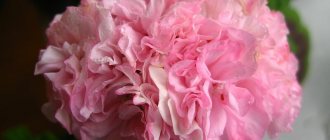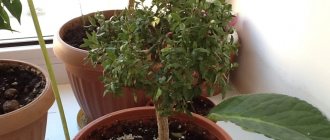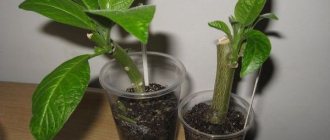Description of Nepalese cinquefoil
Cinquefoil Nepali grows naturally in Nepal and the Western Himalayas. The shrub reaches a height of about 50 cm. The leaves of the plant are large, palmate, and similar in appearance to strawberry leaves.
Cinquefoil can decorate any flowerbed
The inflorescences of the cinquefoil are paniculate and consist of small pink flowers. The plant blooms in the second year after planting. The flowering period lasts 2-2.5 months.
Nepalese cinquefoil has become the basis for hybrid varieties:
- Floris;
- Miss Wilmont;
- Roxana;
- Legend;
- Fiery flame.
Popular varieties
Breeders have developed many hybrid varieties of Nepalese cinquefoil, which differ from each other in the color of the petals and flowering period, but have almost no differences in care.
Miss Wilmont
This is an ornamental shrub no more than 30 cm high with purple stems, on which, during the flowering period (from May to September), large, rich pink flowers appear, forming paniculate inflorescences.
Due to its unpretentiousness, frost resistance and long flowering period, Nepalese cinquefoil of this variety is grown even in the northern regions.
Carmen
This variety of Nepalese cinquefoil forms voluminous ground cover clumps. The calyxes of flowers are located singly or collected in inflorescences, consist of 5 petals, colored dark red with yellow veins and symmetrical stamens.
Herbaceous perennial
A shrub with spreading stems, the leaves of which are similar to strawberry leaves. It reaches a height of 30-85 cm; during flowering, flowers with a diameter of about 3 cm appear on it.
Hybrid
It is characterized by straight stems up to 1 m high, leaf blades located low above the ground and large (up to 5 cm in diameter) flowers of white, yellow, dark red or pink, which are collected in a cyst - or corymbose inflorescences.
Features of planting
Cinquefoil Abbotswood - description and care
The plant is completely undemanding to growing conditions. When growing a crop for good development and abundant flowering, you need to choose a suitable place.
For Nepalese cinquefoil, it is better to choose an open, well-lit area. Planting in partial shade is acceptable, but the lack of sunlight will certainly affect the appearance of the plant, especially the quality of its flowering.
Potentilla has small, richly colored flowers
The process of planting Nepalese cinquefoil is as follows:
- Dig a planting hole about 50-60 cm deep.
- Drainage material must be added to the bottom. It can be gravel, coarse sand, brick chips.
- The next layer is a mixture of soil, humus and sand.
- A seedling is planted and covered with soil.
- Water the planted plant. It must also be carried out within 2-3 weeks after planting, preventing the soil from drying out.
It is important to know! Nepalese cinquefoil prefers loose soils with a high lime content. The best option is loam or sandy loam.
Planting from seeds
Propagating cinquefoil by seed gives good results. Seed material is sown either for seedlings or immediately in a permanent place of growth. To plant seedlings, small seeds are carefully placed in a prepared substrate, covered with film or glass, placed in a warm place and periodically moistened. It is recommended to plant at the end of winter - at the beginning of spring.
Planting seedlings in open ground
When the young plants are strong enough, they are planted in a flower bed. It is advisable to do this, as well as plant seeds in open ground, no earlier than the end of spring, when the ground has warmed up and the threat of night frosts has passed.
The plant blooms from early summer until the first frost
Cinquefoil cultivation and care
How to choose a landing site
In any garden, finding a suitable place to plant a cinquefoil bush is not at all difficult, as this plant is unpretentious and grows in natural conditions even on poor soil not enriched with fertilizers and in direct sunlight.
The plant should receive light and remain slightly shaded. If the shadow is dense, then the bush’s growth will slow down, although flowering will continue. The lighting period should be at least six hours daily.
Despite the fact that the plant can grow in poor soil, it is advisable to add various nutritious fertilizers to it. Then the cinquefoil flowers will be much larger and brighter.
Cinquefoil likes moist, well-drained soil. There is no need to flood the soil abundantly, as water stagnation should not be allowed.
Planting in open ground
To grow seedlings, it is necessary to fill the planting container with soil consisting of garden soil, peat and sand. Everything is added in equal proportions. Seeds are laid out on moistened soil and sprinkled with a layer of sand or earth.
The container is covered with glass on top to retain moisture. After 15 days, the first young shoots will begin to appear. After another 50-60 days, the plant can be planted in prepared soil.
If seeds are sown directly into the ground, this should be done in mid-May. The soil is moistened, seeds are sown on its surface and sprinkled with a thin layer of sand of about three centimeters.
When seedlings appear, they need to be regularly watered and weeded. Planting at a permanent location takes place at the end of August or at the beginning of September.
Do not add unknown components to the soil - there is a correct formula that must be followed
Reproduction
Reproduces in several ways:
| Seeds | planting is carried out in open moist soil in mid-May |
| Seedlings | seeds are planted in a planting box filled with soil |
| Cuttings | the cuttings are planted in a planting hole measuring 50 centimeters in length and width; the bottom of the hole must be filled with drainage |
| Offspring | The shoot is placed in the planting hole and the roots are covered with earth and humus. Watering must be done regularly |
| Dividing the bush | A plant that has reached three years of age must be divided. |
Help: Propagating cinquefoil by dividing the bush is the longest way to grow a plant. If you divide and plant a perennial bush, the Nepalese will bloom only after two or three years.
How to grow from seeds
Seeds are usually planted in the spring, in March or April. Seeds can be planted for seedlings in planting containers, or directly into open ground.
The landing process is quite simple:
- First you need to prepare the ground. Regardless of whether it is a planting container or a temporary growing area, it is necessary to add peat.
- Then you need to moisten the soil a little.
- Next, you need to put the seeds in the prepared soil and sprinkle them with soil on top so that the covering layer is about three centimeters.
- After a month or a month and a half, it is necessary to transplant the seedlings to a permanent place in the garden or flowerbed.
- The soil should be loose and fertilized with nutrients.
Diseases and pests
She gets sick very rarely and is not liked by pests - insects and beetles.
It is extremely rarely affected by rust - a fungal disease that manifests itself as orange round spots on the stems of the bush and its leaves. Rust damage leads to the fact that the green leaves of the bush begin to turn yellow, after which it grows poorly and blooms poorly.
If this disease is detected, it is necessary to spray the bush with a 1% solution of Bordeaux mixture or other insecticides that can be found in flower shops, for example, Fitoverm or Fufanon.
Rust is dangerous not only for cinquefoil. We have already said that rust is one of the most dangerous diseases for mint.
How to care for Nepalese cinquefoil
Cinquefoil Goldfinger - description, planting and care
For good development and long flowering when caring for Nepalese cinquefoil, you must adhere to the following basic conditions:
- Watering. Mature plants do not need constant watering. In dry times, it is enough to keep the soil slightly moist. Mulching the soil can help with this. When watering, it is better to use heated water, since the roots of the plant are sensitive to temperature changes.
- Feeding. The plant needs feeding three times per season: in early spring, during the formation of buds and at the end of summer. It is advisable to use a complex mineral fertilizer with a predominance of nitrogen (at the beginning of the season) and potassium with phosphorus during subsequent procedures.
- Loosening. You need to make sure that there are no weeds growing in the flowerbed where the cinquefoil grows. To do this, they are regularly weeded, and the soil around the plants is loosened shallowly. This procedure helps saturate the soil with oxygen.
- Trimming. Nepalese cinquefoil bushes are prone to overgrowth, so periodically they need to undergo formative pruning. You can give the plantings any shape. Anti-aging pruning is carried out once every 4-5 years - in the spring the plant is cut off completely and be sure to fertilize it. Over the next season it rejuvenates.
Potentilla seeds give good germination
Basic flower care in a flower bed
- Watering . This ornamental crop loves to grow in soil that does not dry out completely. Therefore, in May and summer, in extreme heat, the flower needs to be watered at least 2 times a week.
- Nutrition . It is recommended to feed the flower three times a year with organic matter. The first time is as soon as the snow melts and you see the sprouts of Miss Wilmont. The second is in mid-May (the cinquefoil is in the process of budding at this time). The third - in August, the bushes will have flowered by then, and feeding will help them recover after flowering and strengthen the roots, which is useful for future wintering.
- Transplant . This is not a necessary procedure, because cinquefoil grows well in one place for years. But sometimes a neighbor comes and asks you to plant a couple of bushes for her, or you decide to decorate another flowerbed with cinquefoil... Miss Wilmont is good to replant in early spring. But the end of summer - the beginning of autumn (the period after flowering) is also a good time to transplant such a flower, but only in a warm or temperate climate.
- Bush division . In a flowerbed, cinquefoil grows over time. Every 4 years the bushes should be separated, otherwise they will begin to suppress each other, and this will have a bad effect on flowering.
- Trimming . It is better not to cut the bushes in winter - the old leaves will serve as a natural “blanket” for the flower. In the spring, before the plant wakes up and begins to form young greenery, it is worth removing last year’s growth. Thanks to this, future bushes will turn out neater, and more flowers will bloom on them.
- Diseases . In a rainy summer (or if you over-water) the flower can become infected with a fungal disease - rust. Store-bought medicines—fungicides—can help cure it. But don’t really hope for a “cure for all diseases”, because there are also inevitable diseases - for example, rotting of the root collar, which kills the flower before you even have time to treat the flowerbed. Such rot can also occur from excess watering. That is why you should not neglect the creation of a drainage layer when planting cinquefoil.
- Pests . Miss Wilmont's main enemy is the armyworm, or rather, its caterpillar. These green scoundrels gnaw not only the leaves, but also the flowers of the cinquefoil. When you see these uninvited guests, immediately spray the flowerbed with insecticide. Remember that after a certain time (for most poisons this is a week), the treatment should be repeated. It is worth using the insecticide late in the evening so that the neighboring bees are not affected.
Wintering
If in your area in winter the thermometer does not show the temperature below 20, maximum 25 degrees, you don’t have to worry about bloodroot at all. Especially if the winters are snowy.
If it’s cold here, and there are frequent thaws (the snow melts, and then frosts return), in the fall, cover the flowerbed with Miss Wilmont with agrofibre, or more democratic spruce branches, and fallen leaves.
Benefits and uses of cinquefoil
Although we grow Miss Wilmont and other varieties as an ornamental crop, some people make tea with this plant . In addition to its pleasant taste, this drink also has a therapeutic effect. But, like any other herb, the decoction should be used wisely, because what may be beneficial for some people may be harmful to others.
Nepalese cinquefoil lowers blood pressure - this is good for hypertensive patients, but harmful for hypotensive patients.
The plant is good to drink at night or on a day off. But before you get behind the wheel or engage in a responsible activity, you should not treat yourself to cinquefoil tea. This drink causes drowsiness and relaxation, as well as decreased concentration .
A popular video blogger and simply an excellent gardener will tell you more about this worthy flower (even the legend about the aroma of cinquefoil and Ilya Muromets):
Reproduction methods
Why cinquefoil does not bloom - what to feed
Nepalese cinquefoil is an unpretentious plant in terms of care and propagation. There are several ways to grow it on your plot or dacha:
- Growing from seeds. It is quite possible to prepare the seed material yourself. Ripe seeds are collected in late summer - early autumn. They can be planted immediately as seedlings or stored in a dry place until spring. Seed germination lasts 2.5-3 years.
- Using cuttings. At the beginning of summer, healthy, strong shoots are cut from last year's stems and the lower leaves are removed from them. Some of the resulting seedlings are treated with a solution to stimulate root growth and planted in pots with substrate. To quickly root, it is better for the plant to create greenhouse conditions by covering it with film, a jar or a plastic bottle. Periodically, the seedling needs to be irrigated. After it takes root and strengthens, you can plant it in open ground as an independent plant.
- By division method. This method is suitable for plants that are at least 4 years old. In spring or autumn, in warm weather, a healthy shoot is selected, carefully separated from the mother bush and planted as an independent plant.
- By layering. This method is used most often because it is the easiest to perform. The cinquefoil shoot is cut, bent to the ground and secured with a special pin. Near the cut, the shoot is sprinkled with soil. After the buried shoot forms a normal root system, it can be disconnected from the parent plant and planted separately.
Recommendations for caring for and planting cinquefoil, growing it in the garden
- Landing place.
The plant will do best in a well-lit and open location, but it is necessary that this location be provided with protection from the midday sun. If this rule is not followed, the foliage will begin to fade under the influence of increased lighting levels. But it is also impossible to plant cinquefoil in shade, as this will lead to a slowdown in the growth rate, and flowering may not begin at all. - The soil for planting cinquefoil
is preferably loose and fertile. The soil acidity is recommended to be slightly alkaline with a pH of 5.5–6.5. The best choice is a loamy substrate, into which lime and river sand are mixed. - Planting cinquefoil
directly depends on how old the plants will be placed in the soil. For seedlings, the end of May or the beginning of summer is suitable, cuttings are planted in the summer months (June-July), and for cuttings the best time will be autumn (approximately September-October). The depth of the planting hole should be slightly larger than the earthen ball of the plant. For adult specimens, a hole is dug approximately 50 cm deep. The distance between cinquefoil seedlings will also depend on the variety of Potentilla being grown, but the average values are in the range of 50–60 cm. Before planting the seedling in a hole, a drainage layer is placed at the bottom, which will protect the root system from waterlogging. After this, a little soil is poured onto the drainage layer and the plant is placed. The root collar of the cinquefoil should be at soil level. Then the hole is filled to the top with soil mixture, watered abundantly and the tree trunk circle is mulched using sawdust or well-crushed pine needles. - Watering
plants such as Kuril tea is a particularly important factor. Soil moisture should be regular and abundant. Drying out the substrate is prohibited, since the cinquefoil can quickly die, but the soil should not be waterlogged and stagnation of moisture in it is not welcome. Water for irrigation is taken at room temperature; for this, experienced gardeners take several buckets of water and leave them to warm up under the sun's rays. Only when evening comes, watering is carried out with such a heated liquid. If there is no precipitation in the spring-summer period, then it is recommended to pour half a bucket of water under the cinquefoil bush every day. - Special care requirements.
When it rains or watering occurs, the soil next to the cinquefoil bushes must be carefully loosened, not allowing it to form a crust, which will reduce the access of air and moisture to the roots. Care is needed because the root system is superficial. Weeding is also required regularly. As the buds fade, they are removed. - Fertilizers for cinquefoil
must be applied regularly so that the plant develops better. With the arrival of spring and throughout the summer, it is recommended to use mineral fertilizers with a potassium-phosphorus composition. They can occasionally be replaced with wood ash or a mullein-based solution. - pruned
regularly. With the arrival of spring and in the autumn months, it is recommended to remove all shoots that have become damaged during this time or have begun to thicken the crown of the plant too much. You can use such procedures to form the outlines of the cinquefoil. Spring cutting of branches will stimulate branching, since a large number of lateral shoots will develop, and as a result, multiple flower buds will be formed on them. Once every 4–5 years, it is necessary to perform rejuvenating pruning, when all branches are cut off by one third at once, and in the next couple of years it is recommended to remove all old shoots. When growing annual varieties of cinquefoil, with the arrival of autumn, when flowering is completed, all the stems are cut off, and the area where such plants grew is dug up. For perennials, shelter is not required, as they are frost-resistant. It is recommended to cover only young seedlings with non-woven material, for example, spunbond or lutrasil, during the winter months. - Cinquefoil as an element of landscape design.
Since plants have a wide variety of forms, they can be used for landscaping rockeries and rock gardens, for borders and mixborders, and species with tall shoots are suitable for forming hedges. The best neighbors when growing are delicate daisies and bells, as well as daylilies with yellow flowers.
Possible diseases and pests
In general, the crop exhibits good resistance to diseases and pests. And cases of plant damage by certain diseases are a consequence of violation of the rules of caring for it.
The development of rust in cinquefoil is associated with excess moisture in the soil. When it appears, the plant will have to be treated with Bordeaux mixture or fungicides.
Among the pests, the cutworm, which feeds on flowers and leaves, is most capable of annoying the cinquefoil. Lack of timely treatment can lead to the death of the plant. To get rid of the cutworm, the bushes need to be treated twice with an insecticide solution.
Cinquefoil is widely used in folk medicine
Dangers and contraindications
When using cinquefoil for the prevention or treatment of various diseases, you should be aware of the contraindications:
- Nepalese cinquefoil lowers blood pressure, which is dangerous for hypertensive patients.
- You should not drink cinquefoil decoctions before an upcoming trip while driving a car, before taking exams or before presentations, as this plant causes drowsiness and reduces attentiveness.
Before using cinquefoil decoctions and tinctures, it is necessary to consult a doctor to draw up a treatment program, select a dosage, or identify individual intolerance.
It has no other dangerous properties, however, you should always be careful.
Use in landscape design
Cinquefoil Miss Wilmont is used by modern landscape designers in both single and group plantings. Single plants are most often represented by plantings near borders, on empty ground under tall bushes with bare stems.
Complex compositions of cinquefoil with lupins, cornflowers, as well as plants that are distinguished by inexpressive flowering also look impressive in flower beds. The Legend cinquefoil is often found on alpine hills and among stones.
Cinquefoil Miss Willmott - one of the most colorful hybrids
Beneficial features
Due to the rich content of essential oils and vitamin C, the plant is used in folk medicine, especially for colds.
Cinquefoil Nepali, which is a shrubby perennial plant, is often used for growing at home in the garden. She will need a well-lit place and feeding at the end of the season. In return, the plant will reward you with long-term flowering of abundant flowers of bright colors. Nepalese cinquefoil Miss Wilmont looks especially elegant.
Due to its healing properties, the plant is used in folk medicine for various diseases, especially colds. And even an inexperienced gardener can grow cinquefoil.
How to propagate a plant correctly?
The beauty of Nepalese cinquefoil amazes gardeners, and they have a desire to plant new shrubs on the site. To do this, it is not necessary to go to stores and buy seedlings or seeds. A person can take advantage of what he has.
The methods for propagating shrubs are as follows:
- cuttings;
- dividing the bush;
- seeds;
- layering.
Most often, the vegetative propagation method is chosen, as it is considered the fastest and most effective. The cut parts of the bush quickly form a root and are suitable for planting in spring, summer and autumn. Few gardeners decide to propagate cinquefoil by seeds. But their efforts also bring results, so this method is chosen at will.
The planted sprout often does not take root and dies after a short period of time. This is due to several factors - incorrect selection of location and soil quality. Such nuances must be taken into account.











